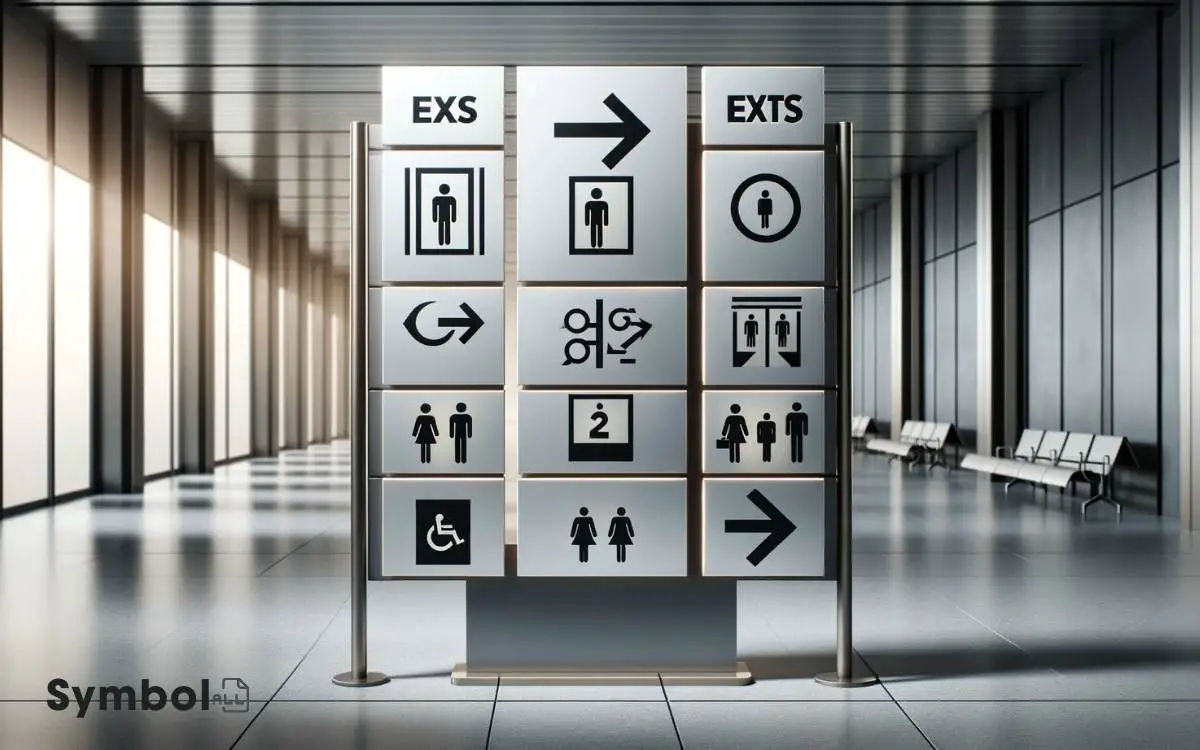There Is a Standard for Signage Which Uses Symbols: ISO 7010
You navigate daily life through symbols, universal icons that provide directions, safety warnings, and accessibility without a spoken word.
Symbols function as a global language, transcending linguistic barriers and ensuring you find your way, understand hazards, and access facilities effortlessly. ISO 7010 sets the standard for these critical symbols, focusing on simplicity, universal recognition, and direct messaging.
Despite widespread adoption, designing universally understood symbols remains challenging due to cultural variations and evolving societal needs.
As symbols adapt to technology and global shifts, they become more intuitive, enhancing your interaction with the world around you. Uncover how these symbols shape your environment and experiences.

Key Takeaways
The Importance of Standardized Signage
Standardized signage acts as a universal language, guiding you clearly and efficiently through unfamiliar spaces. Imagine you’re navigating a bustling airport or a sprawling mall. Without consistent symbols, you’d be lost amidst a sea of information.
These signs, from the restroom symbols to emergency exits, are designed with simplicity and recognition in mind. They transcend language barriers, ensuring that no matter where you’re from or what language you speak, you can understand the message.
This uniformity is crucial for safety, accessibility, and convenience. It allows you to move confidently, knowing that you can rely on these visual cues to lead the way.
In essence, standardized signage streamlines your experience in public spaces, making them more navigable and less intimidating.
Historical Development of Sign Symbols
Understanding the global language of standardized signage invites us to explore its origins and how symbols were first crafted to guide and inform.
Symbols have been a universal mode of communication, evolving from ancient pictographs to the sophisticated, universally recognized icons we see today.
| Era | Key Development |
|---|---|
| Ancient Times | Pictographs used in cave paintings |
| Middle Ages | Heraldic symbols for identification |
| 19th Century | First traffic signs in London |
| 20th Century | Development of safety symbols |
This journey from primitive drawings to modern signs reflects humanity’s ongoing need to communicate important information quickly and effectively.
Each progression laid the groundwork for the symbols you recognize and rely on daily, ensuring safety and clarity in an increasingly complex world.
ISO 7010 and Global Symbol Standardization
Moving on to ISO 7010 and global symbol standardization, you’ll see how design principles shape universally understandable symbols.
You’ll encounter the hurdles of implementing these symbols across diverse cultures and environments.
This segment lays out the groundwork for creating signs that communicate safety and information effectively worldwide.
Symbol Design Principles
To ensure global comprehension, symbol design principles under ISO 7010 employ universally recognizable imagery and clear guidelines. When you’re crafting or interpreting symbols, it’s crucial to focus on simplicity and directness.
These symbols ditch complex designs for straightforward, easily identifiable pictures that convey messages at a glance. Think of a fire exit sign: its vivid green and white color scheme stands out, while the running figure unmistakably points towards an escape route.
This adherence to a minimalistic approach ensures that regardless of your background or language proficiency, you can understand essential warnings, directions, and information.
ISO 7010’s guidelines serve as a blueprint, ensuring that symbols maintain their meaning across different contexts and cultures, making global travel and trade smoother and safer for everyone involved.
Implementation Challenges
Despite the clear guidelines provided by ISO 7010 for symbol design, numerous challenges arise when attempting to standardize symbols globally. You’ll find that cultural differences, legal requirements, and public awareness play significant roles in this process.
Here’s a concise breakdown to help you understand better:
| Challenge | Description | Impact |
|---|---|---|
| Cultural Variances | Symbols may have different meanings across cultures. | Misinterpretation |
| Legal Constraints | Nations have unique laws regarding signage. | Compliance Issues |
| Public Familiarity | Not all symbols are universally recognized. | Reduced Effectiveness |
These hurdles emphasize the need for careful consideration and adaptation in the quest for global symbol standardization. It’s not just about creating a symbol; it’s about ensuring it’s understood and accepted worldwide.
Designing Universally Understood Symbols
As you embark on creating symbols, it’s crucial to grasp the core design principles that ensure clarity and immediate recognition.
Consider how cultural interpretations affect symbol perception, ensuring your designs transcend language and regional barriers.
Prioritize accessibility to make sure your symbols communicate effectively with a diverse audience, including those with disabilities.
Symbol Design Principles
When designing symbols for universal understanding, it’s crucial to prioritize clarity and simplicity above all else. Start with recognizable shapes and forms, ensuring they’re easily distinguishable at a glance.
You’re aiming for intuitive designs that speak directly to the viewer’s experiences, using minimalistic approaches to convey complex ideas efficiently.
Ensure your symbols are scalable, maintaining their meaning whether they’re on a small sign or a large billboard. Colors play a significant role too; opt for high contrast combinations for better visibility, but remember to consider colorblind users by not relying solely on color for meaning.
Lastly, test your symbols with diverse groups to gauge their universality. Feedback’s essential to refine and ensure your symbols break language and cultural barriers, making them truly understood by anyone, anywhere.
Cultural Symbol Interpretation
Understanding symbols beyond their basic shapes requires delving into the complex realm of cultural interpretation, where a single symbol can convey myriad meanings across different societies.
Imagine a simple circle. In some cultures, it represents unity or eternity; in others, it might signify emptiness or a cycle. As you design symbols for universal understanding, it’s crucial to strip away cultural biases and layers of meaning.
Focus on the essence of what you’re trying to communicate. Opt for imagery that transcends cultural boundaries – think basic needs, natural elements, or universally recognized tools.
Accessibility in Symbol Use
To design symbols that everyone can grasp, you must prioritize accessibility, ensuring they’re clear, simple, and universally interpretable.
This means using bold lines and high contrast for visibility. Avoid intricate designs that might confuse or require cultural context to understand. Think about color-blind users; rely on shapes, not colors, to convey your message.
The Role of Symbols in Public Safety
Symbols play a crucial role in ensuring public safety by providing clear, immediate instructions that transcend language barriers. Imagine you’re walking through an unfamiliar airport or train station.
Without a common spoken language, how do you find the exit, restroom, or emergency services? This is where symbols come into play. They guide you swiftly and efficiently, no translation needed.
These visual cues are designed with simplicity and universality in mind. A fire extinguisher sign, for example, doesn’t need words to convey its location.
Similarly, an exit sign communicates its message through a widely recognized figure moving towards a door. By relying on these symbols, you’re able to navigate spaces safely, avoiding hazards and accessing essential services without misunderstanding or delay.
Challenges in Implementing Standard Signage
While standard symbols strive for universal comprehension, diverse cultural interpretations present a significant challenge in their global implementation. You’ll find that what’s intuitive in one culture may be perplexing in another.
This discrepancy can lead to misunderstandings, reducing the effectiveness of such symbols in conveying vital information quickly and accurately.
| Challenge | Description |
|---|---|
| Cultural Variations | Symbols may carry different meanings across cultures. |
| Design Consistency | Achieving a universally recognized design is challenging. |
| Adaptation | Continuous evolution of symbols to match societal changes is slow. |
Overcoming these hurdles requires a careful balance between universal design principles and local sensibilities. It’s a delicate task, demanding ongoing research, collaboration, and education.
As you navigate through these complexities, remember that the goal is to achieve clarity for all, making spaces safer and more navigable for everyone involved.
Future Trends in Symbol-Based Signage
In the face of evolving technology and societal shifts, you’ll witness a dynamic transformation in symbol-based signage. As you navigate through cities and interact with various interfaces, expect to see more intuitive and universally understandable symbols. These advancements will bridge communication gaps, ensuring accessibility for diverse populations and languages. For example, common symbols used in maps, such as arrows, scales, and location markers, may become more standardized and integrated into augmented reality tools to enhance real-time navigation. This evolution aims to create a seamless interaction between people and their environments, fostering greater efficiency and inclusivity.
These symbols will lean heavily on augmented reality (AR) to provide real-time information, enhancing your interaction with the physical environment. Imagine pointing your smartphone at a symbol and instantly receiving detailed, language-independent explanations.
Moreover, the integration of AI will allow these symbols to adapt to cultural and individual preferences, making them even more accessible.
You’re also likely to encounter eco-friendly, energy-efficient signage, using materials and technologies that reduce environmental impact.
This progression towards smarter, more inclusive, and sustainable symbol-based signage is setting a new standard in how we communicate visually in our increasingly globalized world.
Case Studies: Symbol Signage Success Stories
Exploring several notable examples, you’ll discover how symbol signage has revolutionized communication in public spaces. The impact of these symbols extends beyond mere direction; they enhance safety, accessibility, and global understanding.
Here’s a look at some success stories:
| Location | Impact |
|---|---|
| Tokyo Train Stations | Simplified navigation for international travelers. |
| Olympic Venues | Unified communication for a diverse audience. |
| European Highways | Standardized symbols for cross-border travel ease. |
| American Hospitals | Improved emergency and facility navigation for all ages. |
| International Airports | Streamlined passenger flow and reduced language barriers. |
These cases show that effective symbol signage transcends linguistic and cultural barriers, making public spaces more welcoming and accessible to everyone.
Conclusion
As you’ve journeyed through the evolution of standardized signage, from its historical roots to the cutting-edge symbols of ISO 7010, you’ve seen how universal symbols shape our safety and understanding.
But what’s next? Will new technologies reshape our visual language, making symbols even more intuitive? Imagine walking through a world where every sign speaks directly to you, transcending language barriers.
The future holds untold stories of symbol-based signage success. Stay tuned, for the next symbol you encounter might just change the way we see the world.






